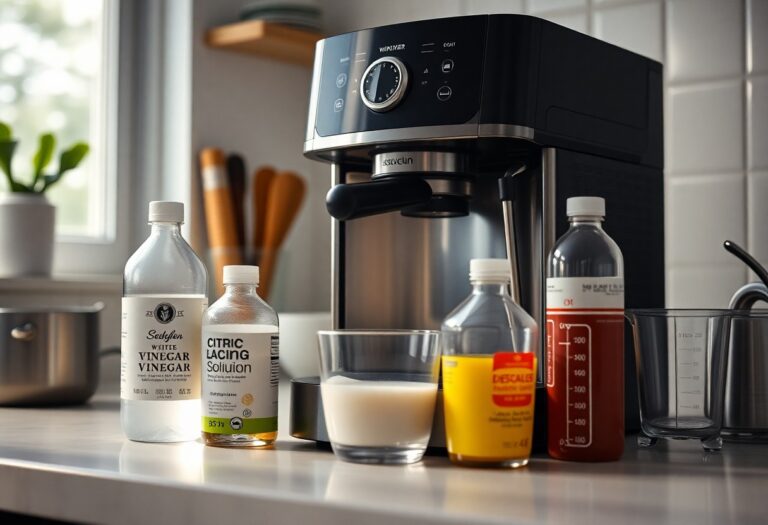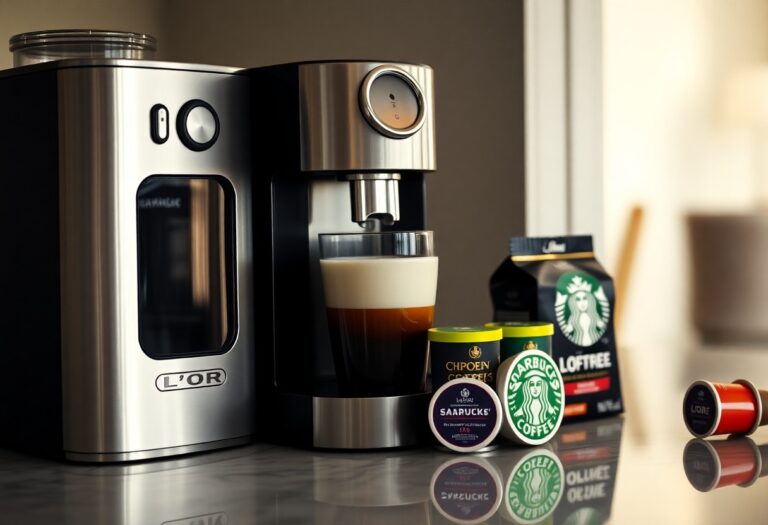How to Use a Coffee Pot Machine – Operating Guide
Over time, mastering your coffee pot machine can transform your mornings and elevate your brewing skills. This guide will walk you through each vital step to ensure you’re brewing the perfect cup safely and efficiently. By following these simple instructions, you’ll discover how to measure water and coffee grounds accurately, understand the importance of proper cleaning, and utilize features that enhance flavor. Get ready to enjoy a delicious cup of coffee made just the way you like it!
Key Takeaways:
- Always start by filling the coffee pot with fresh, cold water and ensure the correct water level for your desired brew strength.
- Use coffee grounds that are specifically designed for brewing, adjusting the amount based on personal taste preferences.
- Place the coffee filter in the basket before adding the coffee grounds to prevent sediment in your brew.
- Choose the appropriate brewing cycle for your model, as different machines may have specific settings for various coffee styles.
- Let the coffee maker finish its brewing cycle before serving to ensure optimal flavor and temperature.

Choosing the Right Coffee Pot for Your Needs
Selecting the perfect coffee pot can significantly enhance your brewing experience. Consider your daily coffee consumption, the number of people you typically brew for, and whether you prefer single-serve, drip, or espresso machines. A personal size pot may work well for one person, while larger families might benefit more from a high-capacity model that brews multiple cups at once. Make sure to think about whether convenience, speed, or the quality of coffee are your main priorities to find the right fit.
Identifying Your Coffee Preferences
Your coffee preferences play a pivotal role in determining the ideal coffee pot. Do you enjoy a robust espresso shot or a smooth drip coffee? Perhaps you love the convenience of a pod system for quick brews. Understanding your taste can guide you toward a machine that complements your flavor profile and brewing habits.
Evaluating Features and Specifications
Examining the features and specifications of various coffee pots can help you make an informed decision. Look for machines that offer adjustable brew strength for customizable flavors, or programmable timers for added convenience. Some models feature built-in grinders, ensuring you have fresh coffee grounds at your fingertips, while others may include thermal carafes to keep your coffee hot without a warming plate, which can alter flavor over time.
When evaluating features, consider the brewing capacity and the type of coffee you primarily consume. If you value convenience, opt for a machine with one-touch brewing and easy-to-read controls. For those who enjoy experimenting, a model with temperature control or brew options (like iced coffee settings or specialty drinks) can expand your coffee horizons. Additionally, energy-saving features and easy cleanup options can significantly enhance your overall experience and satisfaction with your coffee pot.
Mastering the Setup Process
Familiarizing yourself with your coffee pot machine’s setup procedure paves the way for an enjoyable brewing experience. Start by ensuring that you have all the necessary components: the coffee pot itself, a reusable or disposable filter, your favorite coffee grounds, and clean water. Check for any additional features your machine may have, such as programmable settings or built-in grinders, and refer to the user manual to comprehend the specific requirements for optimal setup. Establishing this solid foundation will significantly improve your coffee-making routine.
Preparing Your Coffee Pot for Operation
Before you start brewing, your coffee pot needs a bit of pre-work to ensure optimal performance. Begin by rinsing the carafe and the filter basket with hot water to remove any residual flavors from previous brews. If your coffee pot has a built-in water reservoir, clean it as well, ensuring that there are no soap residues left behind. Filling the pot with fresh water should always be the first step, followed by adding the appropriate amount of coffee grounds according to your desired strength. This thorough preparation sets the stage for a delightful cup of coffee.
Importance of Quality Water in Brewing
The water you use plays a significant role in the quality of your final brew. Using clean, filtered water enhances the flavor extraction, resulting in a consistently rich and enjoyable cup. Hard water, containing high mineral content, can lead to mineral buildup in your coffee pot and affect taste negatively, while tap water with chlorine could easily ruin the subtleties in flavor. Aim for using filtered or bottled water to maintain the best taste and preserve the longevity of your coffee pot.
Consider this: approximately 98% of coffee consists of water, meaning its quality directly affects both the brewing process and flavor profile. For instance, water with a balanced pH, between 6.5 and 7.5, allows for optimal extraction of coffee solubles, resulting in a harmonious cup. Conduct a taste test with different water sources and discover how they influence your coffee’s aroma and flavor. By investing in quality water, you can elevate your brewing game and ultimately enjoy a fresher and smoother cup of coffee every morning.
Brewing the Perfect Cup: Step-by-Step
Begin with fresh coffee beans and cold water to kickstart your brewing process. The quality of your ingredients, especially the beans, can significantly impact flavor. Follow the machine’s instructions closely while referring to this Guide To Home Coffee Makers for optimal settings specific to your device.
Measuring Coffee and Water Ratios
| Coffee | Standard measurement is 1 to 2 tablespoons per 6 ounces of water. |
| Water | Always use filtered water for the best taste. |
Utilizing Brewing Mechanics Correctly
The brewing mechanics of your coffee pot machine should be used to their fullest potential. For instance, if your machine has adjustable temperature settings, select a higher temperature for better extraction of flavors. This ensures the water interacts with coffee grounds at the optimal heat. Keep your equipment clean, as scales and residues can alter the taste of your brewed coffee.
Utilizing Brewing Mechanics Correctly
Maximizing brewing mechanics will enhance your coffee experience significantly. It’s advisable to pre-warm your coffee pot by adding hot water to keep the brewed coffee at its best temperature. Additionally, pay attention to the brewing duration; too short might lead to weak coffee, while too long may cause bitterness. Calibrate your machine according to the manufacturer’s recommendations to bring out the best flavors from your coffee selection.
Essential Maintenance for Longevity
Taking proper care of your coffee pot machine ensures that it not only brews consistently great coffee but also extends its lifespan. Regular maintenance involves a few simple practices, such as thorough cleaning, descaling, and inspecting parts for wear and tear. Implementing these maintenance routines will help you avoid costly repairs down the line and guarantee that your favorite coffee-making appliance remains in peak condition for years to come.
Regular Cleaning Routines
Establish a cleaning schedule for your coffee pot that includes daily, weekly, and monthly tasks. Wipe down the exterior with a damp cloth after each use, and clean the coffee pot thoroughly with warm soapy water. Every few weeks, run a vinegar-water solution through the machine to remove mineral buildup, ensuring the coffee flavors are not compromised by any residues.
Troubleshooting Common Issues
Issues such as leaky coffee pots, strange noises, or coffee that tastes burnt can detract from your brewing experience. Understanding how to troubleshoot these problems can save you time and frustration. Before calling for repairs, check for minor issues like misaligned parts or clogged filters, which can often be resolved quickly.
Further troubleshooting can help get your coffee pot back to its optimal performance. If the coffee pot leaks, inspect the carafe and the brewing basket for cracks or misalignment. For burnt-tasting coffee, cleaning the machine and ensuring that you’re using the correct grind size may improve the flavor. Listening for unusual sounds can indicate that the heating element may be damaged or that a part requires lubrication. Checking these factors regularly will minimize the likelihood of breakdowns and enhance your coffee-making experience.

Elevating Your Brew: Tips and Tricks
Elevating your coffee experience can transform a simple cup into a delightful treat. Here are some tips to enhance your brew:
- Opt for freshly ground coffee beans for a superior flavor.
- Adjust your water-to-coffee ratio to customize strength.
- Use filtered water to avoid unwanted flavors and impurities.
- Experiment with brewing times for different flavor notes.
This will take your coffee-making skills to the next level.
Experimenting with Beans and Techniques
Exploring diverse coffee beans and brewing techniques allows you to discover unique flavor profiles and aromas. Try single-origin beans for distinct tastes or blended varieties for a balanced flavor. Additionally, you can experiment with different brewing techniques, such as adjusting the grind size or using a different brewing method, like pour-over or French press, to modify your coffee’s taste and strength. The versatility of coffee means endless possibilities await.
Incorporating Flavor Enhancements
Flavor enhancements bring new dimensions to your coffee routine. You can start by adding natural ingredients like cinnamon, nutmeg, or vanilla extract to your brew. Consider infusing your coffee with flavored creamers or milk alternatives for added richness. Chocolate shavings or a splash of flavored syrups can also create a delightful twist. For those who are adventurous, try experimenting with spices, or infused oils for unique blends that tantalize your palate.
Incorporating flavor enhancements can elevate your coffee-drinking experience from ordinary to extraordinary. Adding a pinch of salt can cut bitterness, while a dash of cocoa powder can complement various coffee profiles. Remember to keep the additions subtle at first, as this allows you to appreciate the coffee’s natural flavors. Enjoy the process of finding out what works best for you, as even small changes can make a significant difference in your daily cup.
Summing up
Drawing together the insights from this operating guide, you now have the knowledge to effectively use your coffee pot machine. By following the outlined steps—selecting the right coffee, measuring water accurately, and understanding brewing cycles—you can ensure a perfect cup of coffee every time. Don’t hesitate to explore different settings and coffee varieties to personalize your brewing experience, making your coffee rituals even more enjoyable. Embrace these practices to elevate your coffee game and savor each delightful sip.
FAQ
Q: What are the vital steps to set up a coffee pot machine for the first time?
A: To set up your coffee pot machine, first, remove all packaging materials and wash the coffee pot, filter basket, and any removable parts with warm, soapy water. Rinse them thoroughly. Next, place the machine on a flat, clean surface away from heat sources. Fill the water reservoir with fresh water up to the desired level indicated on the machine. If your model uses a coffee filter, place one in the filter basket. Add ground coffee according to your taste preferences, typically one to two tablespoons per six ounces of water. Finally, plug in the machine and initiate the brewing process according to the manufacturer’s instructions.
Q: How do I know how much coffee to use for the amount of water I put in?
A: The general guideline is to use one to two tablespoons of ground coffee for every six ounces of water. However, this can vary depending on your taste and the strength of the coffee you desire. For a milder cup, use one tablespoon, and for a stronger flavor, opt for two tablespoons or more. Many coffee pot machines come with a measuring scoop, which can also help you determine the right amount of coffee to add based on the amount of water.
Q: Can I use pre-ground coffee, or should I grind my own beans for the coffee pot machine?
A: You can use both pre-ground coffee and freshly ground beans in your coffee pot machine. Pre-ground coffee is convenient and widely available, while grinding your own beans often results in a fresher flavor. If you choose to grind your own beans, aim for a medium grind, as finer grinds can clog the filter and coarser grinds may lead to weak coffee. The choice ultimately depends on your personal preference for flavor and convenience.
Q: How do I clean and maintain my coffee pot machine properly?
A: To clean your coffee pot machine, start by unplugging it and allowing it to cool. Remove the coffee pot and filter basket and wash them in warm soapy water. For the machine itself, run a mixture of equal parts water and white vinegar through a brewing cycle to remove mineral deposits. After the cycle is complete, run a couple of cycles with plain water to rinse any remaining vinegar. Additionally, regularly check and replace charcoal filters if your machine has one, and wipe down the exterior and heating plate to keep it clean. Regular maintenance will enhance the longevity and performance of your coffee pot.
Q: What should I do if my coffee pot machine won’t brew or is malfunctioning?
A: If your coffee pot machine is not brewing, first check if it is plugged in and confirm that it is properly connected to a functioning outlet. Ensure that the water reservoir is filled, and the coffee pot is seated correctly on the heating element. You may also want to inspect the machine for any blockages, such as coffee grounds in the filter or buildup in the water lines. If all else fails, consult the manufacturer’s troubleshooting guide in the manual or reach out to customer support for further assistance.







